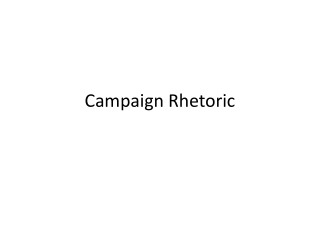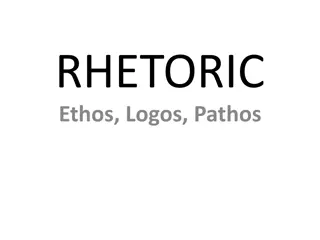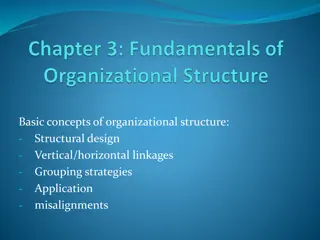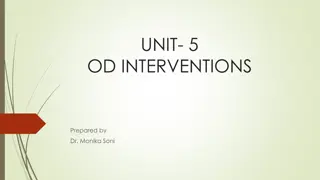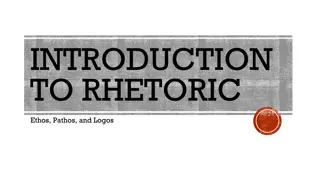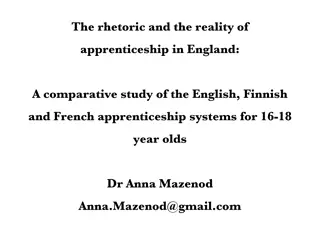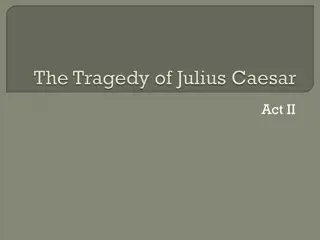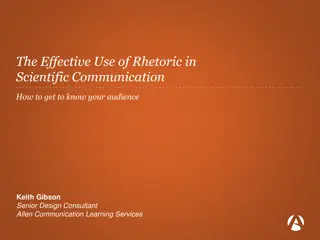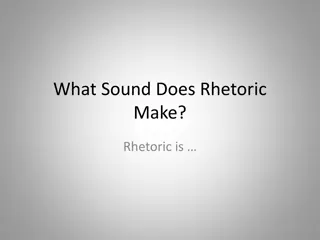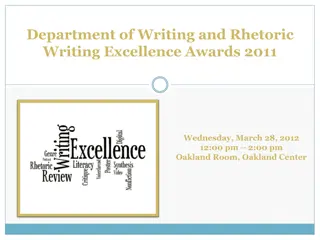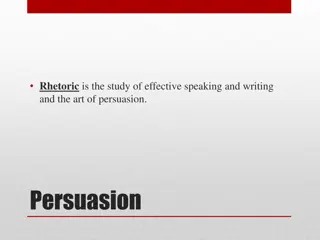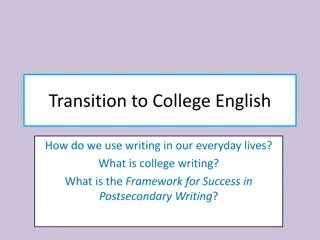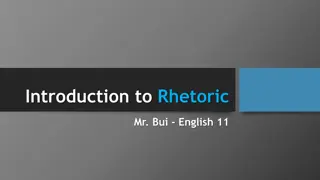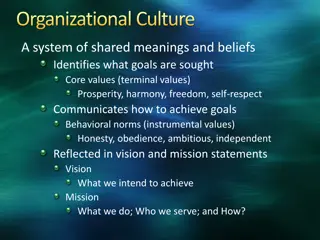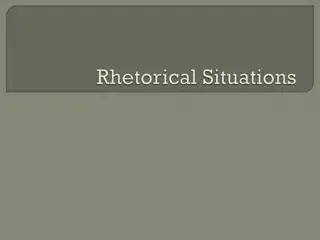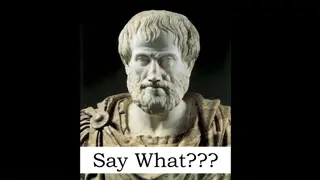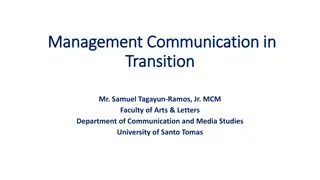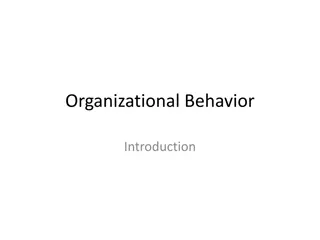Understanding Rhetoric and Organizational Communication
Delve into the world of rhetoric by exploring how symbols influence and persuade audiences. Discover the various applications of rhetoric in different fields like speech writing, public relations, and advertising. Analyze the impact of Disney on shaping childhood culture and imagination. Uncover the skill of sense-making in communication and the ability to interpret multiple meanings within messages.
Download Presentation

Please find below an Image/Link to download the presentation.
The content on the website is provided AS IS for your information and personal use only. It may not be sold, licensed, or shared on other websites without obtaining consent from the author. Download presentation by click this link. If you encounter any issues during the download, it is possible that the publisher has removed the file from their server.
E N D
Presentation Transcript
If you were interested in organizational communication, think about taking CJ 250: Introduction to Organizational Communication OR CJ 111: Gender, Race, Class, and Communication
Rhetoric & Popular Culture Chapter 4
Rhetoric: what is it? Study of how symbols influence (persuade) an audience. Symbols: words, images, nonverbal, cultural practices/ objects, places, etc. Persuasion: modify attitudes, emotions, values, beliefs, behaviors. Any communicator using symbols to reach an audience is using rhetoric.
Rhetoric & Pop Culture Who uses this stuff? Speech writer Campaign management Press Spokesperson Media/Entertainment Public Relations/Outreach Strategic message design Lawyer Minister Advertising (effects) Curator Travel & Tourism Lobbyist Civic Engagement
Reading rhetoric & pop culture Describes the skill of sense-making for a piece of communication. Includes ability to see the implications/results of a message. Sites of meaning: speaker, message, situation, medium, audience. Typically multiple legitimate meanings in any of these variables. Therefore, multiple implications.
Reading rhetoric & pop culture You re reading too much into this. Often a ridiculous statement. Indicates a lack of sense-making skills/sophistication. Suggests that one is unwilling to accept the legitimacy of another s point of reference that spawned his/her reading. Can you put yourself in another s shoes, see the world through their frame of reference.
The rhetoric of Disney To what extent does Disney (or its products ) shape a child s imagination? The culture of childhood? In that shaping, what is Disney providing (what is the message [sender, message, medium, context, audience])? Is it possible to argue that Disney may in some way not be wholesome family entertainment?
The rhetoric of Disney Is it possible to argue that Disney is shaping/defining popular culture nationally and internationally? Does it have lots of control/power? If you re shocked at the questioning of Disney, why? Why should we not at least ask, are there aspects of this power/influence that are problematic?
The rhetoric of Disney The documentary argues that Disney influences the images of femininity and masculinity as well as relationships by her body and nonverbal communication her return to the prince-like man her excusing abusive or inappropriate behaviors on his part If this argument is not (at least in part) true of Disney, then what is the story it s circulating in the public imagination.
The rhetoric of Disney As noted in the internal memo from Michael Eisner, the former head of Disney We have no obligation to make history art statement. To make money is our only objective. What does this mean to the responsibility Disney has as a producer of influential cultural products? When Disney argues (and others repeat), that its just entertainment, isn t that a bit ridiculous?
Why should you care? Power is the ability to persuade (influence) others. Power is the ability to control others. Persuasion control Power is not just physical. It s power over people s symbol use & understanding. The power to persuade (or control) others and their thinking.
Why should you care? Rhetoric shapes the world we see and value. It shapes how we choose to live in the world. It s used by others to shape what we think about and how we think about it. Audiences are not powerless puppets (though we may sometimes act like it). Audiences use strategies of rhetorical resistance, alternative reading. We find sites of rhetorical struggle (alternative meanings).
So what is a symbol? Signifier + Signified = Sign Signifier = human-made symbolic representation. Signified = a thing in our known world Sign = meaning for example ..
So what is a symbol? Signifier + Signified = Sign Signifier: C A T Signified = Sign = Sneezing/allergy, purring, playfulness, mouse-hunter, etc.
So what is a symbol? Signifier + Signified = Sign Signifier: Signified = Sign = Danger/accident, cross traffic, safety, etc.
Are all symbols (or their use) equal? Signifier: T E R R O R I S T Signified: Sign: criminals, enemy, not-patriotic, danger/threat, etc. Rhetors and audiences have the power to define the signifier, signified, and sign (and over symbol use).
Different symbols Indexical Meaning: cause/effect or association
Different symbols Iconic Meaning: based on resemblance
Different symbols Symbolic Meaning: cultural agreement or convention Most symbols carry multiple (correct) denotative and connotative meanings
The Rhetoric in Cultural Artifacts An artifact may be a single symbol (e.g. wedding dress), or a collections that make a unified whole (e.g. movie). Events (e.g. weddings, holidays), actions (e.g. campaign for office, protest), or objects (e.g. book, art, TV program) are artifacts. The collection takes on symbolic status itself. Our attention is drawn to certain artifacts in certain ways AND to certain symbolic structures within those artifacts.
The Rhetoric in Cultural Artifacts The symbolic status (i.e. meaning) of an artifact is often widely shared, with rhetors working hard to keep a preferred reading in the mind of the audience. Audiences may be passive or active participants in that reading. Audiences have different abilities to read. There are ALWAYS multiple ways to read an artifact and those readings do not always compliment each other.
The Rhetoric in Cultural Artifacts We are our symbols. They are our (personal and/or cultural) identity. Our reality is our symbols. We can only think within and see our world from the point of view of the symbolic structures available to us.
Rhetoric = Persuasion = Culture = Power We often hear descriptors defining some culture artifacts as high culture/worthy and others as low/base/unworthy. Why? Who decides? Can things move from one to the other? Whose interests are served by the labels? What do the things within the labels do for us?
Popular Culture as Rhetoric Widely known (popular cultures). Group identification generates PC, PC generates GI. Each of us occupies multiple identifications in varied amounts. Our identities are postmodern they are a mix of genres. Our identifications are sites of tension and contradiction.
Rhetoric & Culture are Ideological As power, as a set of beliefs that elites impose from above in order to get cooperation/adherence. A set of illusionary beliefs (not the truth). A set of beliefs associated in a group & how those ideas are generated.
Rhetoric & Culture are Ideological Ideology is concerned with perception. Artifacts (and symbols) are where perceptions are generated (they are a language). Perception differs from Reality.
Rhetoric & Culture are Ideological Certain perceptions of reality/Reality benefit certain individuals or groups. We willingly participate in some and fight other perceptions via the texts and/or artifacts in popular culture. A text is a collection of artifacts.


